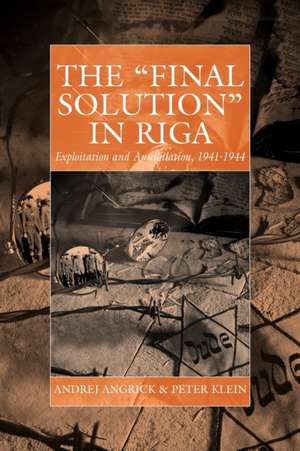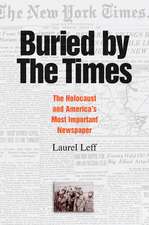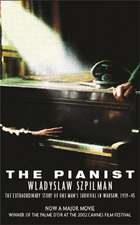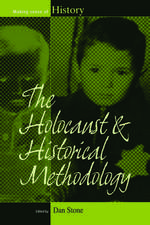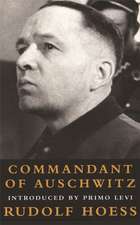The Final Solution in Riga: War and Genocide, cartea 14
Autor Andrej Angrick, Peter Kleinen Limba Engleză Paperback – 31 dec 2011
"[This] excellent study of the Riga ghetto, informed by Eastern European sources and available now in English translation, provides a precise and ghastly description of what [the liquidation] meant for the local Jews. With laudable thoroughness, they describe the organized shooting of Jews, the first form of industrial-scale mass murder." · The New York Review of Books
Ghetto, forced labor camp, concentration camp: All of the elements of the National Socialists' policies of annihilation were to be found in Riga. This first analysis of the Riga ghetto and the nearby camps of Salaspils and Jungfernhof addresses all aspects of German occupation policy during the Second World War. Drawing upon a broad array of sources that includes previously inaccessible Soviet archives, postwar criminal investigations, and trial records of alleged perpetrators, and the records of the Society of Survivors of the Riga Ghetto, the authors have produced an in-depth study of the Riga ghetto that never loses sight of the Latvian capital's place within the overall design of Nazi policy and the all-of-Europe dimension of the Holocaust.
Andrej Angrick, a native of Berlin, is a historian, consultant, and researcher affiliated with the Hamburg Foundation for the Promotion of Science and Culture. He has published numerous articles about the Holocaust in the Soviet Union and co-edited Der Dienstkalender Heinrich Himmlers 1941/42 (1999) and Die Gestapo nach 1945: Karrieren, Konflikte, Konstruktionen (with Klaus-Michael Mallmann, 2009), as well as Besatzungspolitik und Massenmord: Die Einsatzgruppe D in der südlichen Sowjetunion 1941-1943 (2003).
Peter Klein, a Berlin-based historian, consultant, and researcher affiliated with the Hamburg Foundation for the Promotion of Science and Culture, has published widely on the Holocaust and German occupation in various parts of central and eastern Europe during the Second World War. Klein was the editor of Die Einsatzgruppen in der besetzten Sowjetunion 1941/1942 (1997) and a co-editor of Der Dienstkalender Heinrich Himmlers 1941/42 (1999). He is the author of "Gettoverwaltung Litzmannstadt" (2009).
Ray Brandon is a freelance translator, historian, and researcher based in Berlin. A former editor at the Frankfurter Allgemeine Zeitung, English Edition, he is co-editor, with Wendy Lower, of The Shoah in Ukraine: History, Testimony, Memorialization.
| Toate formatele și edițiile | Preț | Express |
|---|---|---|
| Paperback (1) | 350.35 lei 6-8 săpt. | |
| BERGHAHN BOOKS INC – 31 dec 2011 | 350.35 lei 6-8 săpt. | |
| Hardback (1) | 1004.07 lei 6-8 săpt. | |
| BERGHAHN BOOKS INC – 23 noi 2009 | 1004.07 lei 6-8 săpt. |
Din seria War and Genocide
-
 Preț: 182.67 lei
Preț: 182.67 lei -
 Preț: 179.56 lei
Preț: 179.56 lei - 14%
 Preț: 690.77 lei
Preț: 690.77 lei -
 Preț: 179.14 lei
Preț: 179.14 lei -
 Preț: 224.66 lei
Preț: 224.66 lei - 23%
 Preț: 836.20 lei
Preț: 836.20 lei -
 Preț: 264.05 lei
Preț: 264.05 lei - 23%
 Preț: 750.42 lei
Preț: 750.42 lei -
 Preț: 301.20 lei
Preț: 301.20 lei - 23%
 Preț: 751.47 lei
Preț: 751.47 lei -
 Preț: 344.37 lei
Preț: 344.37 lei -
 Preț: 346.57 lei
Preț: 346.57 lei - 23%
 Preț: 834.14 lei
Preț: 834.14 lei -
 Preț: 260.41 lei
Preț: 260.41 lei -
 Preț: 262.14 lei
Preț: 262.14 lei - 23%
 Preț: 805.06 lei
Preț: 805.06 lei - 23%
 Preț: 999.33 lei
Preț: 999.33 lei -
 Preț: 300.45 lei
Preț: 300.45 lei -
 Preț: 259.80 lei
Preț: 259.80 lei -
 Preț: 265.02 lei
Preț: 265.02 lei -
 Preț: 154.49 lei
Preț: 154.49 lei - 23%
 Preț: 1001.09 lei
Preț: 1001.09 lei -
 Preț: 261.38 lei
Preț: 261.38 lei - 23%
 Preț: 748.44 lei
Preț: 748.44 lei -
 Preț: 223.61 lei
Preț: 223.61 lei -
 Preț: 261.38 lei
Preț: 261.38 lei - 23%
 Preț: 837.98 lei
Preț: 837.98 lei -
 Preț: 304.69 lei
Preț: 304.69 lei - 23%
 Preț: 746.06 lei
Preț: 746.06 lei - 23%
 Preț: 836.65 lei
Preț: 836.65 lei - 23%
 Preț: 754.80 lei
Preț: 754.80 lei -
 Preț: 346.11 lei
Preț: 346.11 lei
Preț: 350.35 lei
Nou
Puncte Express: 526
Preț estimativ în valută:
67.05€ • 69.74$ • 55.35£
67.05€ • 69.74$ • 55.35£
Carte tipărită la comandă
Livrare economică 14-28 aprilie
Preluare comenzi: 021 569.72.76
Specificații
ISBN-13: 9780857456014
ISBN-10: 0857456016
Pagini: 530
Dimensiuni: 152 x 229 x 27 mm
Greutate: 0.7 kg
Editura: BERGHAHN BOOKS INC
Seria War and Genocide
ISBN-10: 0857456016
Pagini: 530
Dimensiuni: 152 x 229 x 27 mm
Greutate: 0.7 kg
Editura: BERGHAHN BOOKS INC
Seria War and Genocide
Notă biografică
Andrej Angrick, a native of Berlin, is a historian, consultant, and researcher affiliated with the Hamburg Foundation for the Promotion of Science and Culture. He has published numerous articles about the Holocaust in the Soviet Union and co-edited Der Dienstkalender Heinrich Himmlers 1941/42 (1999) and Die Gestapo nach 1945: Karrieren, Konflikte, Konstruktionen (with Klaus-Michael Mallmann, 2009), as well as Besatzungspolitik und Massenmord: Die Einsatzgruppe D in der sudlichen Sowjetunion 1941 - 1943 (2003). Peter Klein, a Berlin-based historian, consultant, and researcher affiliated with the Hamburg Foundation for the Promotion of Science and Culture, has published widely on the Holocaust and German occupation in various parts of central and eastern Europe during the Second World War. Klein was the editor of Die Einsatzgruppen in der besetzten Sowjetunion 1941/1942 (1997) and a co-editor of Der Dienstkalender Heinrich Himmlers 1941/42 (1999). He is the author of "Gettoverwaltung Litzmannstadt" (2009). Ray Brandon is a freelance translator, historian, and researcher based in Berlin. A former editor at the Frankfurter Allgemeine Zeitung, English Edition, he is co-editor, with Wendy Lower, of The Shoah in Ukraine: History, Testimony, Memorialization.
Cuprins
List of Illustrations Chart I Chart II List of Abbreviations Introduction Chapter 1. Latvia Caught between Two Dictatorships Chapter 2. Operation Barbarossa: Preparations for the German Attack on the Soviet Union Chapter 3. From the Pogroms to the Establishment of the Ghetto Chapter 4. Securing German Rule in Occupied Riga: The Period of the Large Ghetto for Latvian Jews Chapter 5. Murder on a Massive Scale: The Murder of the Ghetto's Latvian Jews Chapter 6. In Search of Territories for the "Final Solution": The Road to Riga as a Final Destination for Deportations Chapter 7. Plans for the Salaspils Camp Chapter 8. The Deportation of German Jews to Riga Chapter 9. The Salaspils Camp: A Detention Center with Many Functions Chapter 10. German Jews Build Salaspils: December 1941 - August 1942 Excursus I: SS Major Rudolf Lange and the Wannsee Conference Chapter 11. The Latvian Labor Market and the Compulsory Deployment of Jews in Riga Chapter 12. The Utilization of Jewish Assets and the Issue of Ghetto Administration Chapter 13. Ghetto Life and Forced Labor in Riga in the Spring of 1942 Chapter 14. The Turning Point: Operation Dunamunde at Jungfernhof and in the "Ghetto for Reich Jews" Chapter 15. Forced Labor and Annihilation in County Commissariat Riga City Chapter 16. Failed Resistance: The Tin Square Operation, October 1942 Chapter 17. Annihilation Instead of Forced Labor: Himmler's Struggle against Production Constraints and Armaments Interests in General Commissariat Latvia Chapter 18. Concentration Camp Kaiserwald and the Barrackings Excursus II: SS Second Lieutenant Fritz Scherwitz, The Commander at Lenta: A Biographical Sketch Chapter 19. The Decommissioning of Concentration Camp Kaiserwald, Evacuation, and Liberation Chapter 20. A New Start and the Search for Justice Chapter 21. Conclusion Bibliography Index
Recenzii
"With its - [over thousand] detailed and expansive footnotes drawing on twenty-four different archive collections in eight countries and three continents and an enormous secondary literature, this is one of the best researched regional studies of the Holocaust ever to appear. It is helped by the fact that the authors are also always so cognizant of what was happening elsewhere in Europe at the same time and thus frequently draw out the relationship between seemingly haphazard local decisions and trends across Europe - Indeed, the way in which the book 'makes sense' of complex institutional behavior is at times breathtaking - The precision in the detail and the scope of the contextualization make this one of the more important works to appear on the Holocaust in recent years." * English Historical Review "This very readable and well documented study fills an important gap in the Holocaust literature: it offers insight into the microcosm reflecting the entire terrifying and murderous scenario of the SS State." * Frankfurter Allgemeine Zeitung "[This] excellent study of the Riga ghetto, informed by Eastern European sources and available now in English translation, provides a precise and ghastly description of what [the liquidation] meant for the local Jews. With laudable thoroughness, they describe the organized shooting of Jews, the first form of industrial-scale mass murder." * The New York Review of Books
